
Last week northern parts of India, particularly Uttar Pradesh and Rajasthan, were torn apart by dust storms of extremely high intensity resulting in the death of about 140 persons, serious injuries to thousands, and damage to property which may run into several thousands of crores. The meteorological department has warned the people of dust storms in the near future but not of that high intensity.
An obvious question arises: was it not possible for the meteorological department to predict the intensity of the dust storms and warn the administration and the people well in time so as to make it possible for them to take preventive steps?
In today’s world, simple smartphones loaded with ordinary weather apps can easily at the touch of a screen or even with an oral command provide a good display of weather for a complete week and at times even for a month. These displays are often quite detailed providing speed and direction of the wind, humidity, chances of precipitation, high and low temperatures, gradual hourly change of temperature, time for sunrise, sunset, moonrise, etc. Many users take advantage of the availability of this information especially for knowing the high and low temperatures, rainfall, and occurrences of dust storms etc.
One can legitimately assume that the meteorological department is much better equipped with a lot more information and sophisticated scientific tools to analyse the information and predict the weather. Gone are those days when the joke doing the rounds was that the person who was not carrying an umbrella during rain must have been the weatherman. The development of meteorological science has been phenomenal in the recent past and with the ability to use computing technology to take into account almost innumerable factors, the accuracy of weather forecasts has been far better than it used to be.
In this context, it is incomprehensible that the meteorological department was not able to predict the intensity of the dust storms and could not possibly anticipate the damage the dust storms would have caused. The role of administrative bodies, typically the disaster management institutions both at the State and Central levels, is crucial to act on the meteorological department’s predictions. The purpose of creating the National Disaster Management Authority (NDMA) in 2005 was precisely to prevent disasters with early warning systems, effective preparedness, mitigating disasters, and alacrity in response. Dozens of reports and plans as to how to manage different natural calamities have been made and many of them are in public domain and easily accessible on the Internet.
Practical applications of understanding of numerous disasters which occur and effective implementation of the strategy formulation are the key indicators of the success of any institution. As is quite obvious, there was no direct connection between planning and action. It could easily have been anticipated with the help of technology as to what would have been the damage by the high-intensity dust storms and in which areas. With effective communication methods using multiple channels of national television, national radio, social media, print and electronic media, local FM radio stations, etc., people could have been warned well in time, which could even have been a few days earlier rather than hours, so as to give them sufficient time either to relocate or to take protective measures at that place itself.
The local administration could have also proactively made certain arrangements – for instance shifting them to safer places like school buildings, community centres, other safe government and private buildings – for the safety of the people. Social media plays a very important role in spreading the message around in incredibly fast manner. This could have been used to the advantage of the people. It is rather surprising that no such action, or very little such action, was seen. Responding only after such disasters take place is not the right approach, especially for disasters which could be predicted and anticipated.
Movement of different types of winds – as meteorological experts have explained the cause of these dust storms – did not happen all of a sudden. Unlike eruption of a volcano or an earthquake, which still are somewhat mysteries for experts, movement of winds depends heavily on the creation of low and high-pressure zones in the atmosphere, which itself is created over a period of time, and not in a jiffy. We surely need a really effective prediction of dust storms and developing the capability to anticipate the damage.
Forewarned is forearmed.
The author is a professor at IIM-A,
akagarwal@iima.ac.in